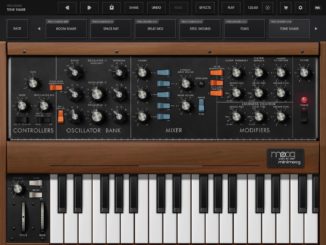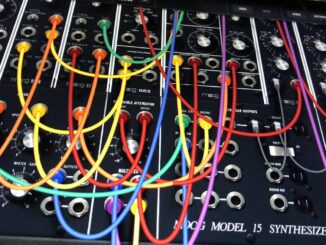Moog Muse 1.4 is a major firmware upgrade that supercharges the analog polysynth with new modulation capabilities and introduces numerous improvements.
I published a review of the Moog Muse in February. It was a positive review, but also with many issues with features or functions that weren’t finished or implemented in firmware 1.3. Among other things, the built-in digital diffusion delay could not be modulated.
Moog already showcased to me at Superbooth 2025 that a new update is in the pipeline and will be released soon, improving many things. Now, three weeks after the Berlin Synthesizer extravaganza, Moog has released the Muse 1.4 firmware.
Moog Muse 1.4
Firmware 1.4 is now available for free download. Moog has given Muse an impressive array of new options in version 1.4, significantly broadening the sound spectrum of the analog polysynth.
Let’s start with the feature I missed in the review, which is now available. With the 1.4 firmware installed, you can modulate the diffusion delay extensively.
It now features various modulation destinations, including independent time L and R, delay time linking, feedback, mix, send, cutoff, multi-tap, diffusion, and more. There is also a new delay send parameter in the MORE menu.
Moog has released a dedicated video on modulating the delay, where you can hear how the modulation massively expands the delay’s sound spectrum. For example, you can now achieve chorus-like effects or create delays with unique, wild textures.
Supercharged Modulation
The modulation capabilities in Muse are impressive. You can modulate almost every parameter, including the mixer faders, modulator with modulator, etc. Not to be forgotten is the ability to add functions between the modulators, making them more complex. Well, that wasn’t enough for the Muse developers, so they supercharged it with more modulation power.
First, Moog Muse 1.4 introduces global modulation, adding six global modulators to its polysynth: LFO 1, LFO 2, envelope 1, envelope 2, random trig 1, and random trig 2.
These new modulators also bring new global modulation destinations, including G LFO 1 rate and G LFO 1 amp, among others. Plus, the mod edits, mod maps, and more, which we know from the per-voice modulation.
Then, LFO 1 and 2 now feature a new creative envelope mode. When you press a key, the LFO will run through a single cycle of its waveform and then pause. This new feature allows you to create new, unique key-triggered movements, especially lovely with the user waves.
All three LFOs (1, 2, and pitch LFO) now also benefit from a new reset function when a sequence starts that can be activated in the More section of each LFO. Besides this, you can now work with new advanced fade functions, consisting of fade A (attack), fade D (decay), fade R (release), and fade AR (attack/release).
These can be placed on any modulator and allow modulation that fades in and out smoothly. There is also a new offset source with a +/- 2 octave range when set to 100% added, as well as more assignable controllers in the MORE section: aftertouch sensitivity and G rand trigger 1/2 trigger source.
A huge update to the modulation engine. I hope it will soon be possible to use user waveforms in the LFOs. This option already exists, but only with factory user waveforms.
Full MIDI & Clock Support
Users who use the Moog Muse with external gear have probably noticed that the MIDI was still a bit choppy in places, especially the MIDI clock, etc. Moog Muse 1.4 also offers a major update on this side.
The new firmware updates bring full implementation of the MIDI Clock in/out and start/stop functionality. It now comes with new clock in /clock in PPQN functions in the MORE menu. Additionally, it now supports MIDI program change control (send/receive) over the patches and sequences.
Other Improvements
Further, Moog Muse 1.4 comes with numerous other improvements, including probably controls for the sequencer on a per-timbre basis and more:
- knob mode: absolute, relative, passthru)
- global tune offset added to the tuning menu (applied to OSC 1, OSC 2, MOD OSC, FILTER CUTOFFs)
- sequencer with workflow improvements: copy steps, double sequence length, duplicate, and more.
- filters: link mode added to MORE menu
- mixer: overload range added to MORE menu
- …
Plus, it ships with many bug fixes.
Moog Muse 1.4: First Impression
Now that’s what I call a significant firmware update. Many of the issues I previously criticized have been addressed, and there are numerous new features that I didn’t expect to be included. I hope that the next updates will bring more patch storage, a plugin librarian, and other neat extras.
Moog Muse 1.4 is available now as a free download for existing users.
More information here: Moog
Available at my partners
Thomann





Great. Now Arturia it’s your turn to give the Polybrute 12 some love…